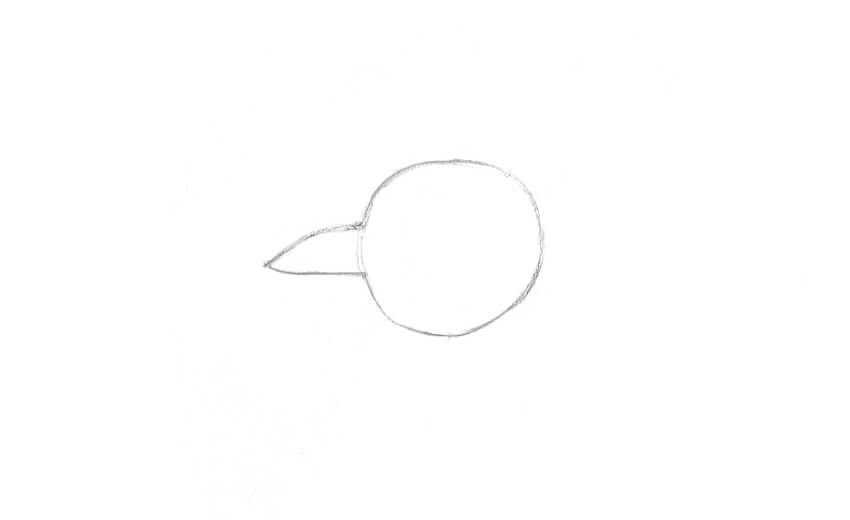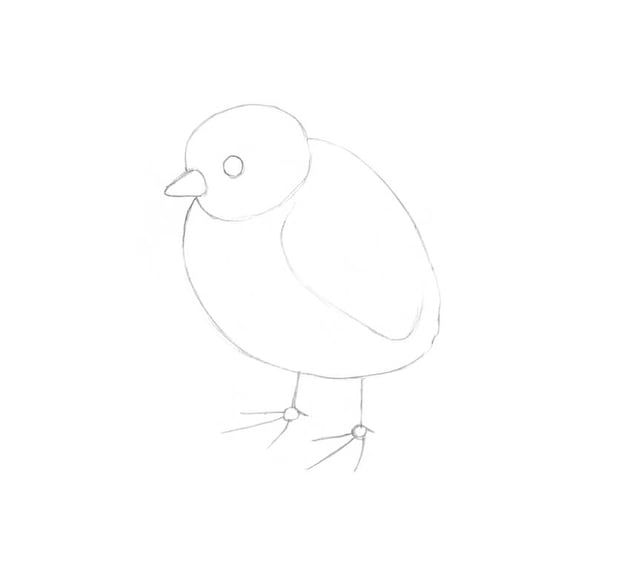There are over 24 billion chickens in the world. Not only do chickens outnumber people more 3 to ane, but there are more than chickens than whatever other kind of bird in the world. Isn't it incredible?
Information technology's difficult to imagine our culture without this widespread domestic bird; it became a symbol that's deeply embedded in mythology, including the Chinese Zodiac.
Let's define the terms: male chickens are chosen roosters, female chickens are hens, and babies are chicks. In this tutorial, we'll observe their distinctive features from a drawing standpoint.
We'll also learn some interesting facts about them along the way!
You may be interested in these drawing tutorials as well:
What You Will Need
In order to complete this projection, you'll need the following equipment:
- an HB graphite pencil
- a 3B graphite pencil
- an eraser
- drawing paper



1. How to Draw a Rooster
Step ane
In this part of the tutorial, we'll be working on a sketch of an adult male chicken and exploring its outward departure from an adult female—a hen.
The ancient Greeks believed that fifty-fifty lions were afraid of roosters, equally evidenced past several of Aesop'south Fables. The rooster is too one of the signs of the Chinese zodiac; information technology is associated with loyalty and corking observation.
With the HB pencil, I showtime with the rough shape of the head, and then add the beak. Exist certain to leave enough space for the rest of the bird on the sheet of paper!



I add the shapes for the rummage and wattle to the bird's head.



Footstep 2
I add a rough trapezium-like shape for the bird'due south cervix.



I add the shape of the rooster's body.



Step three
A rooster has a big tail that consists of long feathers; I mark the surface area where it should be located and the management of feathers.



Step 4
Let's describe the bird'south feet. I outline the fluffy thighs start.



Then I add the remaining parts of the anxiety (the shanks), using lines and small circles to marking the joints.
Our rooster has iii primary toes (they are longer) and ane small dorsum toe.



Pace v
I refine the head of the bird, adding the significant details: the center, the ear (at the side of the caput), and the earlobe only near it. And so I define the points of the rummage.
By the way, chickens have total-color vision, just like we do! Also, they tin distinguish more than 100 'faces' of members of their species.



Step half dozen
I refine the contours of the bird'south body, making information technology stouter. Feel gratuitous to erase the unnecessary pencil lines every bit y'all go.



Step vii
I draw the anxiety, based on the framework. The rooster should have spurs at the dorsum of the anxiety and claws at the tips of the toes.



Step 8
I add the wing, too marking the contour of the long feathers that are hanging downward (they are called saddle feathers).



Step 9
It's time to refine the tail of the rooster. Actually, the feathers of different parts of a chicken'south body have dissimilar names; for case, the long, curling, showy feathers of the rooster'due south tail are called sickles.
I draw the feathers that are closer to the body.



I add the curling sickles; don't be agape to make them long and opulent.



Stride x
With lite pencil lines, I mark the feathers on the rooster'due south body. The long, thin feathers around the cervix are called hackles.



Step 11
With the HB graphite pencil, I apply some graphite hatching to the cartoon, paying particular attending to the head, wing, and tail details.
The shanks have a subtle relief and may exist slightly fluted, then I emphasize this characteristic.



Step 12
I increment the contrast, using the softer 3B pencil. The sketch is complete!



Step thirteen
Yous may ask, what is the difference in the advent between a rooster and a hen? Permit's wait into it.
A hen has a seemingly heavier torso. The feet are shorter, and the tail can't boast of long, showy feathers—the hen's feathers are short and mainly straight. The rummage is smaller, too.
The image shows the general proportions of an adult female person chicken. We won't be repeating the whole drawing process all over again because it's very similar to sketching our rooster—so merely grasp the main features of the hen'southward advent.



Step fourteen
The feathering of a hen ordinarily creates a smoother, softer impression. It's important to accentuate the hackles—they create a variety in covering.
All chickens have buds on their legs from which spurs tin can grow. In nearly hens, they remain latent, but sometimes they become long and prominent.



Stride xv
The pattern of the plume varies from breed to brood. Alternating darker and lighter spots is a sure option to attain a credible look!



2. How to Draw a Chick
Pace one
Nosotros are already familiar with developed chickens, so it'due south time to draw a infant chicken. I start with the head, calculation the shapes of the eye and the modest beak right abroad.
By the way, mother hens talk to their unborn babies, and they answer through their shells. Isn't information technology ambrosial?



Pace ii
I add the rough shape of the chicken'due south trunk; information technology is quite small compared to the caput. The neck is very short, barely visible.



Step 3
I describe the contour of the chicken's small wing.



Footstep 4
I add the framework of the curt feet.



Stride 5
I refine the center (let'southward brand it big and cute!) and the pecker. This chicken is very immature, and so it doesn't take the prominent head details that the adult birds have.



Stride 6
I refine the feet. From a structural standpoint, they are quite like to the feet of an adult bird, but they look exaggerated considering a baby chicken is small and doesn't accept all the thick, voluminous feathering.



Stride 7
I soften the contours of the chicken's body with an eraser and create an illusion of fluffy plumage, using long pencil lines.



Stride 8
I add some hatching to the drawing, using the HB graphite pencil. The lines imitate the fluffy roofing of the chick's body.



Step 9
With the 3B pencil, I increment the contrast, accentuating the head and the bottom role of the body. A drop shadow is a finishing touch that makes the cartoon more credible.



Your Drawings Are Complete
Congratulations! You've created beautiful drawings of a wonderful craven family. I promise you've enjoyed the process.
May your further creative journey be fruitful and full of joy!



DOWNLOAD HERE
How to Draw a Hen and Chicks TUTORIAL
Posted by: barbarahervelp1962.blogspot.com